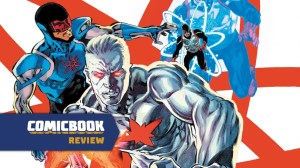
James Bond #1 could have started a lot of different ways, but I think the scene it starts on is both the best possible choice and incredibly ballsy. The first half of this comic is comprised of a single action sequence with the first speech balloon appearing on page 8 filled with only three words. It’s quick and quiet, lacking the slick aesthetics many have come to associate with the James Bond franchise at the movies. This rejection of what is familiar, forgetting about the similar rough-and-tumble start of Casino Royale, helps to establish a clear thesis for James Bond as a comic book, marking both what kind of Bond story this is and how Warren Ellis and Jason Masters plan to tell it.
Videos by ComicBook.com
The rejection of the most iconic styles and elements from the films, specifically the slickness of Roger Moore and Pierce Brosnan, isn’t just different for the sake of difference. It is a return to the source material, the much more complex and morally troubling depiction found in Ian Fleming’s novels and stories. As a recent devotee of Fleming’s work, I instantly recognized this version of the character at the start of the comic and the setup for a broader adventure to follow.
Both chase and confrontation are quick and brutal. Violence is instantaneous with barely a gutter between action and bloody reaction. There is no glamorization to be found here. Instead, the ugliness of murder is accepted at face value, which provides a less heroic but more nuanced representation of 007 himself. His acceptance of violence and its subtle impact upon him make for a story that feels far more spy than super spy.
Masters’ construction of the chase scene at the beginning of James Bond is much more effective at portraying tone than story. He shifts the focus of his panels to avoid revealing Bond’s face until the climax of the sequence. This is effective for the first several pages, but once the two men begin to interact it actively interferes with the reading experience by drawing attention to itself. Bond is no longer hidden to the man he chases, but is still obscured from the reader for reasons that are cute at best. It limits the impact of close combat and fails to effectively make the chased man a point of view character.
This failure is the result of a single decision and not an overall lack of quality. Masters delivers quality comics for the rest of the issue and always conveys the necessary information in each scene with only an odd lettering choice ever threatening to confuse. What really pulls his sequential art above the level of workmanlike is his simple construction of Bond’s face. In a few carefully chosen lines he makes the legend easily distinguishable and capable of evoking a wide range of reactions from childish charm to a sharp, but purposefully obscured, intellect.
That range can be found throughout the second half of the issue as Masters and Ellis draft Bond’s supporting cast into the story in quick succession. M, Moneypenny, Q, and Felix all make appearances or are at least referenced. Each of them evokes a different relationship and aspect of Bond’s personality that can be found in both dialogue and facial language. Bond is found to be a complex individual in what could have been a slog of exposition setting up the plot of “VARGR”. They bring readers to question who this pop culture icon really is, humanizing the man and obscuring his inner self simultaneously.
James Bond #1 may defy the expectations of many readers, but this is almost certainly a good thing (especially if said readers are actively seeking Brosnan era antics). Ellis’ displays an obvious affection for the source material here, but it is an affection tempered by literary understanding and appreciation. Rather than writing fan fiction, he is drawing out the elements of Fleming’s finely dressed killer that most engage him. Masters is more than capable of playing up both the violence and the charms inherent in this take as well. Together they are well equipped to provide a new spin on a man who seems to have lived a dozen different lives already.
Grade: B



